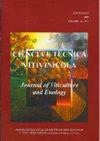Differential genetic stability in vineyards of the cultivar ‘Italy’ (Vitis vinifera L.) cultivated in different regions of Southern and Southwestern Brazil
IF 1.1
4区 农林科学
Q4 FOOD SCIENCE & TECHNOLOGY
引用次数: 4
Abstract
During more than 50 years the vegetative propagation has been the form of maintaining and multiplication of the cv. ’Italy’ vineyards, a ’Bicane’ x ’Muscat Hamburg’ hybrid. In the current study, polymorphism in 17 microsatellite loci was used to evaluate the genetic stability at DNA level in vineyards of cv. ’Italy’ planted in different regions of the states of Parana and Sao Paulo, Brazil. Unchanged and equal allele frequency indicating genetic stability was reported in 47% of the microsatellite loci in vineyards of six localities, while allele frequency variation has been observed in Scu15vv, Udv44, Udv74, Udv96, Udv107, Udv108, Vvmd5, Vvmd6 and Vvs3 microsatellite loci. Alleles Udv96 140 and Vvs3 448 , detected in vines in only one of the vineyards, evidenced somatic mutations at molecular level in cv. ’Italy’. Genetic diversity, as result of changes in the allele frequencies in 53% of microsatellite loci, was detected more frequently than somatic mutations due to new alleles. Polymorphism in microsatellite loci revealed different genetic stability in vineyards of cv. ’Italy’ cultivated in six different Brazilian regions and indicated vineyards with less genetic stability as a possible source of somatic mutants, showing traits of agronomic interest with a potential to generate new cultivars.栽培于巴西南部和西南部不同地区的“意大利”(Vitis vinifera L.)葡萄品种的差异遗传稳定性
在过去的50多年里,无性繁殖一直是维持和繁殖变异的一种方式。“意大利”葡萄园,“比堪”和“马斯喀特汉堡”的杂交品种。本研究利用17个微卫星位点的多态性,在DNA水平上对葡萄的遗传稳定性进行了评价。“意大利”种植在巴西巴拉那州和圣保罗州的不同地区。在6个地区的葡萄园中,47%的微卫星位点的等位基因频率不变且相同,表明遗传稳定性,而在Scu15vv、Udv44、Udv74、Udv96、Udv107、Udv108、Vvmd5、Vvmd6和Vvs3微卫星位点的等位基因频率发生了变化。等位基因Udv96 140和Vvs3 448仅在一个葡萄园中检测到,在分子水平上证明了体细胞突变。“意大利”。遗传多样性是53%微卫星位点等位基因频率变化的结果,比新等位基因引起的体细胞突变更频繁地被检测到。微卫星位点的多态性揭示了葡萄品种遗传稳定性的差异。“意大利”在巴西六个不同的地区种植,并指出遗传稳定性较差的葡萄园可能是体细胞突变的来源,显示出具有产生新品种潜力的农艺性状。
本文章由计算机程序翻译,如有差异,请以英文原文为准。
求助全文
约1分钟内获得全文
求助全文
来源期刊

Ciencia E Tecnica Vitivinicola
Agricultural and Biological Sciences-Food Science
自引率
12.50%
发文量
5
期刊介绍:
Ciência e Técnica Vitivinícola (Journal of Viticulture and Enology) is an international journal that publishes original articles, research notes and review articles, written in Portuguese or in English, on the various fields of the science and technology of vine and wine: Viticulture, Enology and Vitivinicultural economy.
 求助内容:
求助内容: 应助结果提醒方式:
应助结果提醒方式:


